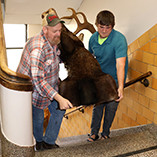12,000 Specimen Donation Triples Inventory at Northwestern’s Museum of Natural History
April 15, 2024
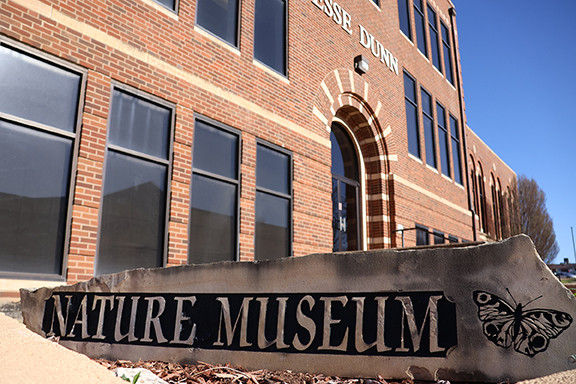
The Northwestern Museum of Natural History now has some nice signage to help show visitors where it is located using the west doors into Jesse Dunn.
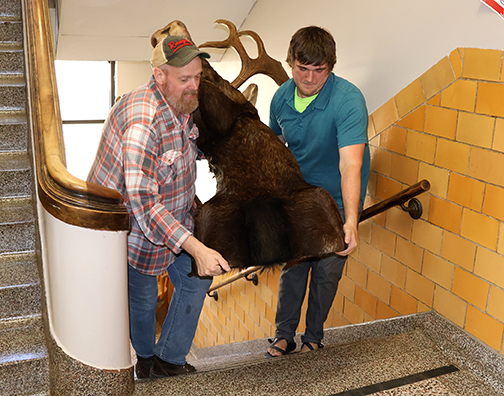
This moose head is the largest item donated to the Northwestern Museum of Natural History from the Gypsum Hills Nature Museum. Museum directors Thomas Cornell (left) and Dr. Nicholus Ledbetter successfully maneuvered the sidewalks and stairs to get the piece into the museum. |
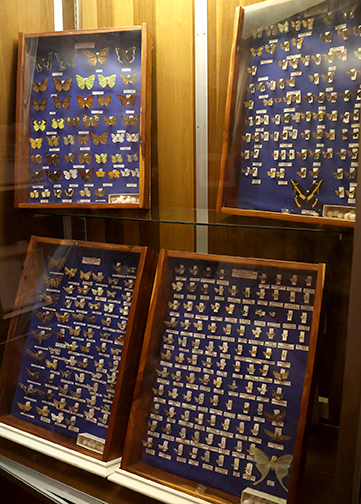
Moths, butterflies and other insects are among the 12,000 specimens recently donated to the Northwestern Museum of Natural History from the Gypsum Hills Nature Museum in Hardtner, Kansas. |
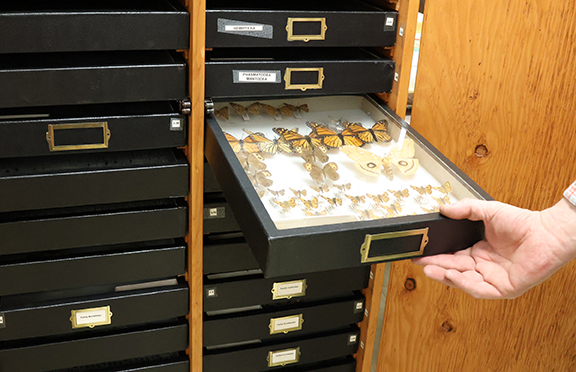
These butterfly specimens are among many other items recently donated to the Northwestern Museum of Natural History. |
The items may not be sizable, but their quantity certainly makes up for it.
A recent donation of about 12,000 specimens to the Northwestern Oklahoma State University Museum of Natural History from the owners of the Gypsum Hills Nature Museum in Hardtner, Kansas, has tripled the inventory of Oklahoma’s second-oldest museum.
The portion of the collection the museum received from Bill and Janet Smith, who recently closed their museum to move to Alaska, deals largely with rocks, beetles, butterflies and moths from Woods County specifically and Oklahoma more broadly.
“This donation is massive and beautifully preserved,” said Dr. Nicholus Ledbetter, assistant professor of biology and co-director of the campus museum. “We will likely have one of the bigger insect collections in the state, potentially top five.”
Thomas Cornell, assistant professor of visual arts and museum co-director, said that the moths and butterflies have already been used in his visual arts courses including the natural history drawing class and the professional practices and gallery administration class. These students have put together a display to show a few of the species donated and may be viewed in the museum on the second floor of Jesse Dunn from 1-5 p.m. Monday through Friday.
Megan Valdez, Alva junior majoring in general studies, said the class members have been learning how museums and galleries set up their exhibits, what measurements are needed for the space and deciding what objects or species will be shown.
Ledbetter found out about the possibility of this donation during an MTG or Magic the Gathering Commander Club night at the Cherokee Strip Museum where he and Cornell play the trading card game every second Friday.
He said that not only did the museum obtain a myriad of cool insect specimens, it also received all of the equipment needed for the staff to make its own specimens, which he is excited to use in his zoology class.
Cornell said the agriculture department also plans to use the donation in its classes as it was given pinning boards for the collection of moths and butterflies.
“As we accession and inventory the collection, we plan on sharing the generosity that was shown to us by sharing what is redundant to our collection or resources that might act better as part of the university’s teaching collections to the relevant departments,” Cornell said.
Ledbetter also noted that this expanded collection could also be helpful with the efforts he and Cornell have been making this past year to acquire outside funding for museum improvements.
Northwestern’s Museum of Natural History was established in 1902 by G.W. Stevens, head of the biology department at that time. According to the museum’s web page, in 1908, Stevens and former student assistant and protégé, T.C. Carter, traveled to Alaska where they spent seven months collecting hundreds of specimens of mammals, birds and bird eggs to bring back to the campus museum. These materials were added to the already extensive collection of specimens native to the Oklahoma area.
Cornell noted that because a large portion of the current museum’s collection came from that trip to Alaska, it seemed fitting to accept the donation of a moose head from the Hardtner museum collection so that it might continue to be displayed and shared with those who visit the campus museum.
“Their museum was a real treasure that consisted of multiple sub-collections,” Cornell said. “The majority of the larger taxidermy animals went to the Cherokee Strip Museum in Alva, and I look forward to seeing them on display there.”
For more information about the museum, contact Ledbetter at (580) 327-8673 or nmledbetter@nwosu.edu or Cornell at (580) 327-8111 or tacornell@nwosu.edu or visit https://www.nwosu.edu/school-of-arts-and-sciences/natural-science/museum-of-natural-history.
To learn more about the Northwestern Department of Natural Science, visit https://www.nwosu.edu/school-of-arts-and-sciences/natural-science, and for more information about the visual arts program, visit https://www.nwosu.edu/school-of-arts-and-sciences/fine-arts/visual-arts.
-NW-
